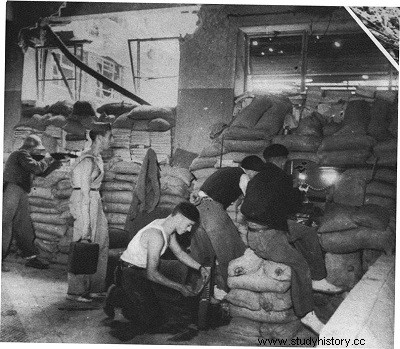
This fierce fight continued for two weeks, with both sides strengthening at the same rate so that neither could gain the upper hand. In an attempt to demoralize the million people of Madrid and also to satisfy the curiosity of German officers eager to see the reaction of the civilian population during a methodically organized operation to destroy a city, General Franco ordered Madrid to be bombarded 24 hours on 24 using high explosive charge bombs followed by incendiary bombs. But the suffering that the people of Madrid then had to endure united them more closely than ever, despite very heavy losses - a thousand deaths between November 16 and 19 - the city's defenses resisted and morale remained high.
Furthermore, mastery of the skies no longer belonged to German or Italian aircraft which now often clashed with Soviet fighters, including a small, stocky monoplane, the Polikarpov II-16 Rata, probably the best fighter of the world at that time. Soviet bombers fast enough to evade Nationalist fighters, apart from the recent Italian Caproni, could reach the various towns held by the rebellion.
At the end of November, the Nationalists had 60,000 men on the Madrid front in the Toledo-Brunete sector, while the Republicans had only 40,000 in the perimeter of defense which, finally, had been correctly fitted out thanks to with the help of Soviet technicians. The Republican infantry was structured on the model of the nationalist banderas:three infantry companies, one of machine guns and supporting artillery and tank units. The Nationalists realized that Madrid could only be taken with the help of a very large number of men supported by massive air and artillery bombardment.
Franco, Mola and Varela held a conference at the end of November and agreed on the necessity of throwing the Republicans back across the road from Madrid to the Escorial to relieve their troops engaged in the Casa de Campo. It was decided that, if the attack succeeded, the advance would be continued in order to isolate the Republican forces operating in the Sierra from the capital, and thus deprive the city of water and electricity.
The Republican ranks broke under the battering of a Legion bandera and had to retreat to the suburbs of Pozuelo and Humera; but when the Nationalists engaged their tanks to turn the retreat into a rout, they ran into Soviet armor fire and were forced to retreat. Their Ju52 bombers were shot down by Russian fighters or forced to flee. The affair did little to benefit the nationalists and resulted in heavy losses on both sides. the North-west. Four mobile brigades, totaling 17,000 men, attacked Boadilla del Monte, preceded by the strongest artillery fire of the entire war and intense aerial preparation. The Republicans retaliated with their Russian tanks and fighters and counter-attacked with fresh units of International Brigades.
The battle raged for four days and left only a few square kilometers for the Republicans who, however, clung to the tactically important villages of Boadilla and Villanueva de la Canada. But six battalions of the International Brigade had been almost totally decimated. On the nationalist side, the losses were such that new combatants from Morocco had to be called in and many young people sent to the front.
New plans were drawn up to complete the encirclement from the city; an eastward movement was projected from the southern sector in order to cross the Jarama River and cut the roads to Valencia. This offensive constituted the right pincer of the pincer movement, the left one to be launched southwest of Guadalajara by regular battalions of Mussolini's army. Once cut off from the rest of the Spanish republic, Madrid was condemned to die.
In fact neither the battle of Jarama nor that of Guadalajara gave the expected results and Madrid survived it, as well as further attempts over the next two years.
When the battle ended. a few months before the start of World War II, the front lines in the Sierras, Casa de Campo, and University City were nearly identical to those at the end of 1936.
The Madrid's valiant resistance ended at the same time as the Spanish Civil War. Shortly after. Franco's nationalist government was recognized by all the great powers of the world, apart from the Soviet Union.
Four months after the departure of the Condor Legion for Germany. six panzer divisions—the spearhead of the Wehrmacht—entered Poland. it was the beginning of the second world war. Warsaw, after Madrid and other Spanish cities, was to experience aerial bombardment. The Blitzkrieg using tanks and planes, the effectiveness of which had just been tested in Spain, was to experience the successes that we know.
